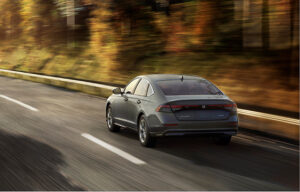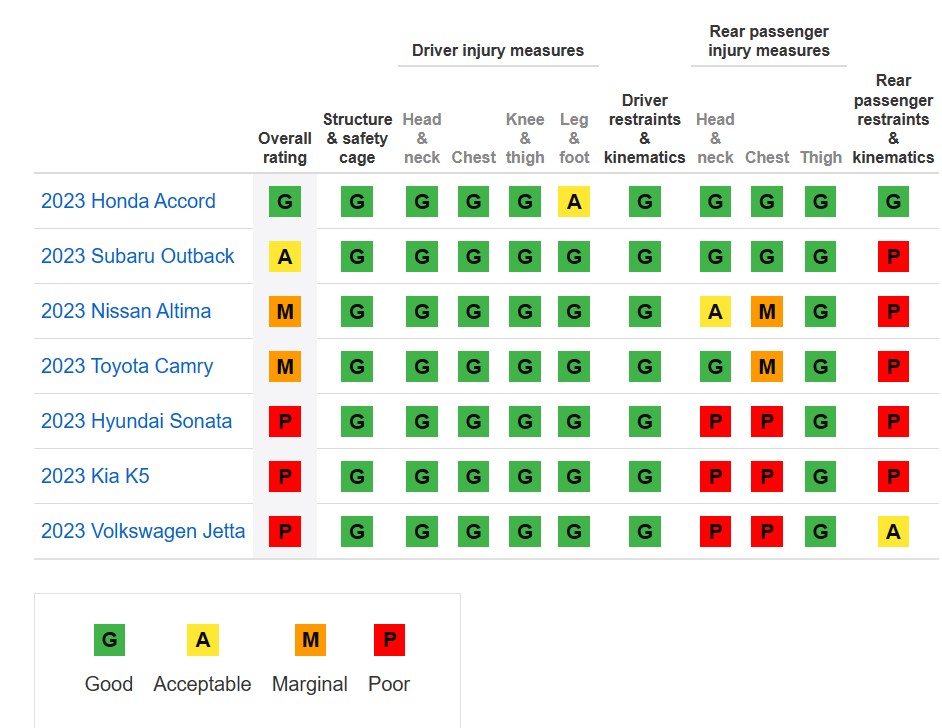
IIHS: Honda earned ‘rare’ good rating in updated crash test
By onAnnouncements | Collision Repair
The Honda Accord was the only midsize car tested to receive a good rating in the Insurance Institute for Highway Safety’s (IIHS) new rear-seat protection evaluation.
The updated moderate overlap front test was launched last year after research indicated that in newer vehicles, the risk of death is higher for restrained rear seat passengers than it is for those traveling in the front seat.
This doesn’t mean backseats have become more dangerous, IIHS said, but rather indicates that front seats have become safer due to improved air bags and seat belts that aren’t normally available in the back.
The new test is meant to “encourage manufacturers to improve rear-seat protection,” by placing a dummy in the rear driver’s side seat, IIHS said. While the driver dummy is the size of an average adult man, the rear dummy is the size of a 12-year-old child, it said.
“For a vehicle to earn a good rating, there can’t be an excessive risk of injury to the head, neck, chest or thigh, as recorded by the second-row dummy,” IIHS said. “The dummy should remain correctly positioned during the crash without submarining. The head should also remain a safe distance from the front seatback and the rest of the vehicle interior, and the shoulder belt should remain on the shoulder, where it is most effective. A pressure sensor on the rear dummy’s torso is used to check the shoulder belt position during the crash.”
Of the seven vehicles IIHS included in the crash simulation, the Accord 2023 outperformed them all while earning its “rare” good rating, it said. Also tested were:
-
- The 2023 Subaru Outback, the only vehicle to receive an acceptable rating;
- The 2023 Nissan Altima, rated marginal;
- The 2023 Toyota Camry, rated marginal;
- The 2023 Hyundai Sonata, rated poor;
- The 2023 Kia K5, rated poor; and
- The 2023 Volkswagen Jetta, rated poor.
While all seven cars provided “good protection” in the front seat, IIHS said its measurements indicated a slightly higher risk of right leg or foot injuries in the Accord which provided “stellar protection” in the back seat.
Testing indicated the rear dummy showed no heightened risk of injuries and that the Accord’s seatbelts adequately controlled its motion, IIHS said.
That wasn’t the case for the other vehicles put to the test.
“In most of the midsize cars we tested, the rear dummy slid forward, or ‘submarined,’ beneath the lap belt, causing it to ride up from the pelvis onto the abdomen and increasing the risk of internal injuries,” said David Harkey, IIHS president. “In the three poor-rated vehicles, measurements taken from the rear dummy also indicated likely injuries to the head or neck as well as to the chest.”

IIHS said submarining was a problem for both the K5 and Sonata, while in the Jetta the backseat passenger’s head came too close to the front seatback. In all three of the cars, testing indicated that backseat passengers were likely to sustain injuries to their head or neck, and chest.
For the Altima and Camry, the problem was that the rear dummy slid beneath the lap belt moved off the shoulder and toward the dummy’s neck. In the case of the Altima, it indicated a moderate risk of head or neck injuries for the rear passenger, IIHS said.
Although testing didn’t indicate any elevated injury risks for the rear passengers in the Outback, it did find the dummy slid beneath the lap belt and that its head came close to the seat back during the crash. Those findings indicated that there’s a likelihood of abdominal and head injuries following impact, IIHS said.
“As in the original test, the structure of the occupant compartment must maintain adequate survival space for the driver, and measurements taken from the driver dummy shouldn’t show an excessive risk of injuries,” it said.
When asked to comment on how Honda’s design helped it gain the best rankings, a spokesman pointed Repairer Driven News to a press kit detailing how the Accord’s Advanced Compatibility Engineering (ACE) body structure has improved.
“This latest version of the ACE structure in the new Accord features a new structure that incorporates many of the new features introduced on the 11th-generation Civic and 2023 HR-V and CR-V,” the OEM said. “This includes a robust upper member constructed of high-strength steel, and an A-pillar structure, side frame and lower firewall structure all designed to route crash energy around the cabin, especially in oblique impacts.”
Honda added that side impact protection has been enhanced to meet tougher side impact standards.
The OEM also addressed its advanced air bag and seat belt technologies.
“Seatbelt technology has been updated as well, with an outer lap belt pretensioner used on front seatbelts, with a load limiter used on the driver’s side to prevent chest injuries,” Honda said. “In the rear, Accord now features pretensioners in both outboard positions, along with load limiters and a rear seatbelt reminder, which informs the driver if a rear seat occupant is not properly buckled up.”
Joseph Young, IIHS spokesman, said the 2023 Accord’s restraint system was effective in controlling the dummy’s movement during the crash while also limiting pressure to the chest that could cause injuries.
“Some of this is likely due to Honda incorporating some advanced belt technologies into the rear seat,” Young said. “These include crash tensioners and force limiters, which are not as common in the back seats as up front. Crash tensioners help pull the occupant into a more ideal position as the crash begins, while force limiters allow the belt to spool out slightly during the crash to limit forces to the chest. Those belt technologies alone don’t guarantee a good rating in the new test, but we are seeing that vehicles with the technologies are generally performing better. The Accord’s rear seat belt also did a good job of staying in the ideal position during the crash to limit any potential forces on the abdomen.”
Young said IIHS expects many automakers to begin incorporating such advanced belt technologies into vehicle back seats.
“At the same time, they’ll need to pay attention to the seat belt geometry and possibly make changes to the seat design to better restrain the occupant in a frontal crash,” he said. “Some automakers may need to look at side airbag timing and coverage as well. We expect automakers with models that haven’t performed well to respond quickly. We’ve already seen some evidence of this with models tested previously.”
Young added: “One important reminder is that the safety belt remains the most important piece of safety equipment in your car. More advanced belt technologies and improvements in vehicle structure won’t do you any good if you don’t buckle up. We know that people are less likely to buckle up in the back seats, so we want to remind folks to buckle up for every trip regardless of seating position.”
